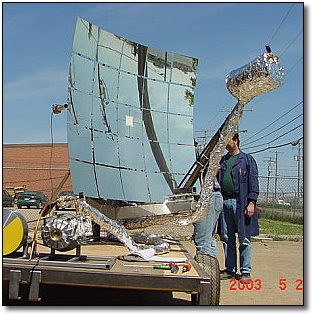
Image: SHEC Labs
 |
Are solar
concentrators the answer to mass-produced hydrogen? Image: SHEC Labs |
| Saskatoon, Canada,
May 28, 2004 [SolarAccess.com] Roughly a year after unveiling the
company's solar energy concentrator, Canada-based Solar Hydrogen Energy
Corporation (SHEC) is following the sun down south into Arizona for the
first round of field testing for the device. The company's test unit, which they call a "Solar Catalytic Hydrogen Generator," was recently put into field operation at the APS Solar Test and Research facility in Phoenix, Arizona. Known more commonly as the STAR facility, the testing grounds are covered in nearly every variety and make of solar photovoltaic (PV) and solar thermal applications from tried-and-true products to experimental units. Considering the fiercely competitive nature of the solar PV industry, one testing direction for the STAR facility has been to compare the advertised electrical generation capacity of major brand solar PV modules, with what they actually produce.  A wide variety of solar modules undergo testing at the APS STAR facility While this has been a big part of the facility's research, another direction has become quite relevant. Hydrogen production. Despite what critics say about it, hydrogen is the latest buzzword in the clean energy arena since U.S. President George W. Bush announced support for the associated technologies in his 2003 State of the Union speech. Unfortunately, many fear the Administration is really deploying a "bait and switch" approach, purporting support for clean, renewable energy technologies, while ultimately pursuing hydrogen production through coal, nuclear, or other traditional energy industries. That's what makes testing of the SHEC unit and others like it so important. "APS is interested in the advancement of renewable energy technologies that can make electricity and hydrogen fuel affordable, and available on a large scale," said Herb Hayden, APS Solar Program Coordinator. "Concentrating solar power in particular has tremendous potential for hydrogen production in the US southwest." SHEC's unit uses a system of mirrors to concentrate the sun's energy much like a satellite dish concentrates data frequencies to a central receiver. In the company's previous press release from last June, SHEC said their unit could concentrate sunlight by a factor of 5,000 times. "This heat energy is then removed and applied to a useful purpose, if not removed, this energy can melt steel in seconds," Beck said.  The SHEC solar concentrator unit SHEC-Labs Hydrogen Generator uses a proprietary catalyst, a new solar collection technology and solar tracking and process software developed by the company. The system as designed produces hydrogen from natural gas, or by electrolyzing water at temperatures of 800 degrees Celsius. The solar technology being used allows for pollution-free manufacturing of hydrogen, said the company. The testing which is anticipated to take about two weeks, will be used to provide valuable information to the research and development team. They will be testing specifically for temperature fluctuations, solar tracking capabilities, hydrogen output and general system reliability. The data will also be used to improve the design of future systems, which will be built on a much larger scale. "We believe we have designed a state of the art system which will positively impact the cost effective production of clean Hydrogen in the future," said Tom Beck, President of SHEC-Labs. SHEC isn't the only company with the same goal in mind either.  The Stirling Energy Systems (SES) 25 kW solar energy concentrator dish. SHEC's unit holds a striking similarity to the larger units offered by the nearby Phoenix, Arizona-based Sterling Energy Systems (SES). That company's units are based on Dish Stirling solar concentrators undergoing testing through the U.S. National Renewable Energy Laboratory. SES recently unveiled a process to mass produce their 25 kW units on a large scale for either electricity or hydrogen production. SHEC seems to be right at their heels. Whether the answer to mass-produced hydrogen from the sun is solved by SHEC, the SES dish stirling units - or some other approach altogether - it's clear that hydrogen has become the next major frontier for energy experimentation. |
|
|
| For
Further Information: • SHEC • Related story of SES Stirling units on SolarAccess.com • APS Star Testing Facility Please Note: SolarAccess.com and Arizonaenergy.org do not endorse the sites behind these links. We offer them for your additional research. Following these links will open a new browser window. |
Copyright © 1999 - 2004 - SolarAccess.com
Please visit www.solaraccess.com for great coverage on energy today!!